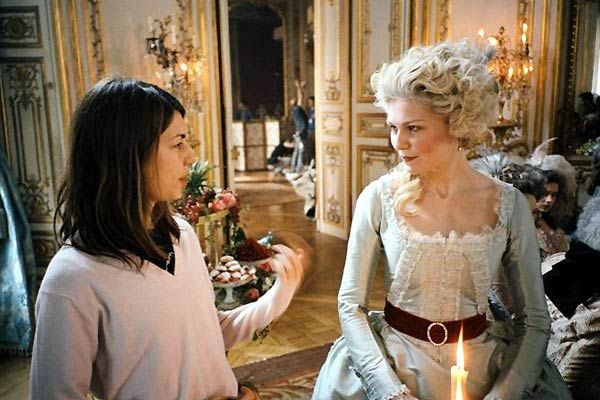Sofia Coppola
37. Marie Antoinette, directed by
Sofia Coppola
A Cinematic Soufflé if I’ve Ever Seen One
By Rose Marel
Movies based on historical events or figures are not necessarily historically accurate, as proved in Sofia Coppola’s glorious Marie Antoinette. Based on the (in)famous Austrian teenager turned French Queen, Coppola’s film whips up a treat that’s just as humanising as it is grandiose. Consistent to her bold and moody directional approach, Coppola doesn’t concern herself with historical exactitude. Instead she converges history with modernity, like reinventing an old coat for a new generation of consumers. While the basic situational circumstances of the Antoinette-Louis XVI reign are inherent to the plot, it’s through Coppola’s directional liberties that we can more fully realise them.
So what are these so-called basic circumstances? It’s 1770 and according to royal customs, it’s been arranged that fifteen-year-old Marie Antoinette (Kirsten Dunst) will wed sixteen-year-old Louis XV1 (Jason Schwartzman) from France. Their union is one singularly based on politically strategic benefit and Antoinette is shipped off (with 57 carriages, 117 footman and 376 horses) to Versailles, like an expensive parcel to be unwrapped. And unwrapped she is, literally torn from her old life and possessions before being cloaked in the new.
Versailles becomes her new ‘home’, but those childhood fantasies we all entertained about castle dwelling soon prove to be less than ideal. I mean… living in a palace isn’t exactly homely, especially when courtiers refuse that you ever lift a finger and then proceed to watch and gossip about your every breath. Versailles, too, is a palace of the most excessive, gold-dipped opulence, a place so spectacular it demands to be separated from humanity, divided by our awe.
Incredibly, the film was shot on location in the real Versailles. Its sumptuousness and vastness could almost be mistaken for hyperbole if it weren’t real. Becoming its own force, Versailles itself demands attention, typifying the role of appearance within the royal sphere and the urging of social elitism. By Coppola’s suggestion, it’s an extension of Antoinette’s status as the ‘celebrity’ equivalent of the 18th Century. Coppola uses this thematic parallel as a bridge between the old and new, injecting contemporary leanings into historical retelling.

But back to the story: Antoinette and Louis XVI’s courtship doesn’t quite go according to plan. Like a blind date gone (very) wrong, the chemistry between the pair is non-existent. There’s not even a glimmer of platonic spark, let alone a romantic or sexual one. Resultantly, the marriage goes unconsummated for years. A bustle of courtiers and a lack of a male heir causes an inevitable flurry of rumours which quickly trickles into the public consciousness.
Antoinette’s taste for parties and frivolity soon adds to the growing distaste towards her. Orientating the protagonist within a new-age impressionist tone, Coppola paints Antoinette as something akin to an American teenage celebrity: rich, bored, lonely and plied with extravagant opportunity. Her existence is watched on a dual level, both by the courtiers and the public. Hers is a life of conspicuous consumption, which is virtually fed to her by the plethora of servants and resources that swarm about. In turn, this culture becomes a constant reminder of her superiority, raising her within a context that encourages special treatment.
We see how the eventual Queen is placed in the centre of a gilded bubble. And while fun and games may keep her entertained, the reality of such a life is one of isolation. All the decadence is a mere distraction; the status is really segregation; a false sense of security that will only lead to a violent brisance. The slightly jarring effect of modern influences – like the anachronistic music accompanying the 18th Century costumes and setting – acts as an underlying reminder that Antoinette perhaps doesn’t quite belong. Similar to Coppola’s Lost In Translation, the director relies on visuals and mood to explore the melancholy of isolation and the discombobulating effect of a foreign environment.

No doubt this is one of Coppola’s strongest skills, her ability to bring a strong visual element to her films, which in turn elevates the atmosphere and audience connection. Here, the sorbet hued set and extravagant costumes paint scenes as delectable as the cake Marie Antoinette eats. Saturated with colour and enhanced by the real Versailles, Marie Antoinette bursts off the screen. You can almost taste the richness, and this visual excess offsets Antoinette’s feelings of detachment.
Coppola also emphasises the youth and naivety of Antoinette and, in doing so, affirms her humanity. Kirsten Dunst is believable as the youthful Queen, not equipped to deal with the role thrust upon her. We gain an understanding into her ignorant and oft criticised quote: she’s so young and sheltered that it’s almost understandable. The infamous (and debatably false) line “Let them eat cake” is lathered with rich irony as Antoinette reclines in a bath.
Clever, innovative and bloody beautiful,Coppola’s Marie Antoinette is a film of relevance in our celebrity and gossip-obsessed culture, while offering more than a taste of history. This film is so visually appealing, it’s worth watching just to feast your eyes upon such opulence!